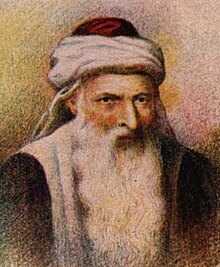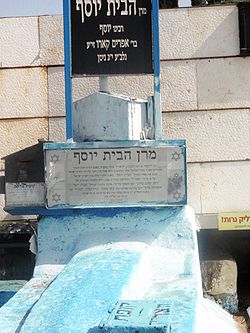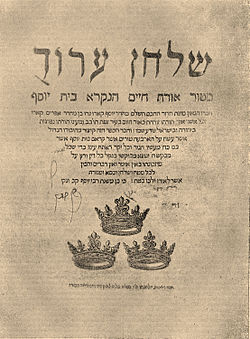Joseph Karo
This articleneeds additional citations forverification.(March 2024) |
Rabbi Joseph Karo | |
|---|---|
 Artistic conception of Karo's appearance.Painting of 19th century | |
| Title | הַמְחַבֵּרHaMechaber מָרַןMaran |
| Personal | |
| Born | Joseph ben Ephraim Karo 1488 |
| Died | March 24, 1575 |
| Religion | Judaism |
| Signature |  |
| Buried | Safed Old Jewish Cemetery |
Joseph ben Ephraim Karo,also spelledYosef Caro,orQaro(Hebrew:יוסף קארו;1488 – March 24, 1575, 13Nisan5335A.M.),[1][2]was the author of the last great codification of Jewish law, theBeit Yosef,and its popular analogue, theShulhan Arukh.To this end he is often referred to asHaMechaberor "The Author" (Hebrew:הַמְחַבֵּר) and asMaranor "Our Master" (Jewish Babylonian Aramaic:מָרַן).[3]
Biography[edit]
Joseph Karo was born inToledoin 1488.[3]In 1492, aged four, he wasexpelled from Spainwith his family as a result of theAlhambra Decreeand subsequently settled in theKingdom of Portugal.[4]Following his father's death, Karo's uncle Isaac, an author of biblical commentary, adopted him.[5]After theexpulsion of the Jews from Portugalin 1497, the Ottomans invited the Jews to settle withintheir empire.Karo went with his parents, after a brief move to Morocco, toNikopolis,then a city under Ottoman rule. In Nikopol, he received his first instruction from his father, who was himself an eminentTalmudist.He was married twice, firstly to Isaac Saba's daughter, and, then after her death, to the daughter of Hayyim Albalag, both of these men being well-known Talmudists.
Between 1520 and 1522 Karo settled atAdrianople.He later settled in the city ofSafed,Ottoman Galilee,where he arrived about 1535, havingen routespent several years atSalonica(1533) andIstanbul.By 1555, Joseph Karo was already a resident of the villageBiriyyanear Safed, during which year he completed writing the first order of theShulhan Arukh,Orach Chayim.[6]
Rabbinic career[edit]
For a short while he lived in Nikopol, but decided to make his way to theLand of Israelso that he could immerse himself inits sanctityand complete his written works. Passing through Salonica, he met the greatkabbalistJoseph Taitazak.He continued his journey to the Holy Land via Egypt and eventually settled inSafed.
At Safed he metJacob Beraband was soon appointed a member of his rabbinical court. Berab exerted great influence upon him, and Karo became an enthusiastic supporter of Berab's plans for the reinstitution ofsemicha(rabbinical ordination) which had been in abeyance for over 11 centuries. Karo was one of the first he ordained and after Berab's death, Karo tried to perpetuate the scheme by ordaining his pupilMoshe Alshich,but he finally gave up his endeavors, convinced that he could not overcome the opposition to ordination. Karo also established ayeshivawhere he taughtTorahto over 200 students.
A Yemenite Jewish traveler,Zechariah (Yaḥya) al-Dhahiri,visited Rabbi Karo'syeshivain Safed, incirca1567 CE[7]and wrote of his impressions:[8]
I journeyed from Syria, the province, through Upper Galilee, unto the city of Safed, the land of Canaan.… I then came into the city, and lo! Within her dwelt the Divine Presence, for within her there is a large community, frowardness being removed far from them, about fourteen thousand in number! In eighteen seats of learning they had come to study the Talmud. There, I saw the light of the Law, and the Jews had light. They surpassed all other communities.… Then it was that I knew my estimable worth, based on all my strength and ability, and lo! I had been deficient in several matters. Now, 'that which is lacking cannot be numbered'.[9]I made myself inconspicuous in her midst, while my thoughts were languorous. Within the synagogues andmidrashicstudy halls I had come to hear the expositors who expound upon a certain matter in several ways, seeing that they know every secret thing, from the walls of the ceiling, all the way down to its foundation – but, especially, the great luminary, even the wise man, Rabbi Joseph Karo, from whose seat of learning the wise men of Safed do not quit themselves, for in his heart the Talmud is stored, after he had sat down in learning for seven years, within a confined chamber. Now, aside from several branches of wisdom, within his heart are sealed, both, revelations and mysteries. I went one Sabbath to his seat of learning, to see his honourable and glorious magnanimity. I sat down by the entrance, alongside the doorpost of the gate, while my cogitations from foolishness were sorely gripped by fear. Now, that wise man the elder sat upon a chair, and with his mouth he did amplify the subject matter. By an utterance he would draw man away from his burthen caused by the vicissitudes of time, in drawing him nigh unto the faithful God. He would then clothe him, as it were, in sumptuous apparel fit for those who are free, by his recital of the verse: 'The Law of the Lord is perfect, reviving the soul'.[10]He then deliberated on a certain matter by explicating its plain and esoteric sense. Before him were seated about two-hundred very admirable and distinguished pupils, sitting upon benches. When he had finished his words of wisdom, he gestured to a certain disciple opposite him to speak.… Now, when that wise man (i.e., Rabbi Joseph Karo) heard the words of that disciple, he was astonished by his eloquence of speech who had given plausible arguments about the soul, and he then raised him up and exalted him above all the pupils that were with him.… I stayed there awhile, until the wise man (i.e., Rabbi Joseph Karo) had gestured to his pupils to stand up, and then gave order to each one to learn aMishna.So they went their way, the pupils who were there gathered and the wise man (i.e., Rabbi Joseph Karo).[11]

When Jacob Berab died, Karo was regarded as his successor, and together with RabbiMoshe of Tranihe headed the Rabbinical Court of Safed. In fact, by this time, the Rabbinical Court of Safed had become the central rabbinical court in all ofOld Yishuv(southernOttoman Syria), and indeed of thediasporaas well. Thus there was not a single matter of national or global importance that did not come to the attention and ruling of the Safed Beth Din. Its rulings were accepted as final and conclusive, and Karo's halachic decisions and clarifications were sought by sages from every corner of the diaspora. Rabbi Joseph Karo was also visited in Safed by the great Egyptian scholars of his day, RabbiDavid ibn Abi Zimraand RabbiYaakov Castro.He came to be regarded as the leader of the entire generation.

In a dramatic testimonial, RabbiShlomo Alkabetztestified that in Salonica, Karo had become one of the rare individuals who merited to be instructed by amaggid—a private angelic teacher who revealed to him many kabbalistic teachings. The maggid exhorted Karo to sanctify and purify himself, and he revealed to him events that would take place in the future. InShaarei Kedusha,RabbiChaim Vitalexplains that visitation by a maggid is a form of Divine Inspiration (ruach hakodesh). The teachings of the maggid are recorded in his published work titledMaggid Meisharim,although RabbiChaim Joseph David Azulainotes that only about one fiftieth of the manuscript was ever published, (see Works). However, in numerous places inMaggid Meisharimit is stated that, "I am the Mishna that speaks in your mouth," indicating that the Oral Torah itself (of which the Mishna is the fundamental part) spoke within him. (However, these two explanations are not necessarily contradictory—in the merit of the Mishna Karo constantly reviewed, he was worthy of an angelic teacher).
The Maggid promised him that he would have the merit of settling in the Land of Israel, and this promise was fulfilled. Another promise, that he would merit to die a martyr's death sanctifying God's Name likeRabbi Shlomo Molchohad merited, did not transpire for an unspecified reason.
His reputation during the last thirty years of his life was greater than that of almost any other rabbi sinceMaimonides.The ItalianAzariah dei Rossi,though his views differed widely from Karo's, collected money among the rich Italian Jews for the purpose of having a work of Karo's printed; andMoses Isserlescompelled the recognition of one of Karo's decisions atKraków,although he had questions on the ruling.
When some members of the community ofCarpentras,France,believed themselves to have been unjustly treated by the majority in a matter relating to taxes, they appealed to Karo, whose letter was sufficient to restore to them their rights (Rev. Etudes Juives 18:133–136). In the East, Karo's authority was, if possible, even greater. His name heads the decree of excommunication directed against Daud,Joseph Nasi's agent; and it was Karo who commissionedElisha Gallicoto draw up a decree to be distributed among all Jews, ordering thatDei Rossi's "Me'or 'Enayim" be burned. But, Karo dying before it was ready for him to sign, the decree was not promulgated, and the rabbis of Mantua contented themselves with forbidding the reading of the work by Jews under twenty-five years of age. Several funeral orations delivered on that occasion have been preserved (Moses Albelda,Darash Mosheh;Samuel Katzenellenbogen,Derashot), as well as some elegies from Karo's passing.
Published works[edit]

Karo's literary works are considered among the masterpieces ofrabbinic literature.He published during his lifetime:
- Beit Yosef(בית יוסף), a commentary onArba'ah Turim,the current work ofJewish lawin his days. In this commentary Karo shows an astounding mastery over the Talmud and the legalistic literature of the Middle Ages. He felt called upon to systematize the laws and customs of Judaism in face of the disintegration caused by the Spanish expulsion.
- Shulchan Aruch(שולחן ערוך), a condensation of his decisions inBeth Yosef.Finished in 1555, this code was published in four parts in 1565.[12]
- Kessef Mishneh(כסף משנה) (written in Nikopol, publishedVenice,1574–75), a commentary ofMishneh TorahbyMaimonides.In the introduction, Karo writes that his goal was to quote the source of each law in the Mishneh Torah, and to defend the work from the criticisms of the Ravad, RabbiAbraham ben David.[13][14]
After his death there appeared:
- Bedek ha-Bayit(בדק הבית) (Salonica, 1605), supplements and corrections toBeth Yosef;
- Kelalei ha-Talmud(כללי התלמוד) (Salonica, 1598), on the methodology of theTalmud;
- Avkath Rochel(אבקת רוכל) (Salonica, 1791),Responsa
- Maggid Meisharim(מגיד מישרים) (Lublin, 1646), and supplements (Venice,1646)
- Derashot(דרשות) (Salonica, 1799), speeches, in the collection 'Oz Tzaddikim'.
Maggid Meisharim[edit]
TheMaggid Meisharim(1646,Preacher of Righteousness) is a mystical diary in which Karo during a period of fifty years recorded the nocturnal visits of an angelic being, his heavenly mentor, the personifiedMishna(the authoritative collection of Jewish Oral Law). His visitor spurred him to acts of righteousness and even asceticism, exhorted him to study the Kabbala, and reproved him for moral laxities.
Burial place[edit]
He is buried inOld Cemetery of Safed.
Other notable rabbis also buried in Old Cemetery of Safed:
References[edit]
- ^Rabbi Joseph KaroArchived2009-01-14 at theWayback Machine,OU
- ^"Joseph ben Ephraim Karo | Jewish scholar | Britannica".britannica.Retrieved2021-12-11.
- ^abJoseph ben Ephraim Karo,Britannica
- ^Wilke, Carsten L. (2007).Histoire des Juifs Portugais.Paris: Chandeigne.ISBN9782915540109.
- ^The Shulchan Aruch,My Jewish Learning
- ^Ishtori Haparchi(2007). Avraham Yosef Havatzelet (ed.).Kaftor wa-Ferach(in Hebrew). Vol. 2 (chapter 11) (3 ed.). Jerusalem. p. 53 (note 14).OCLC32307172.
{{cite book}}:CS1 maint: location missing publisher (link) - ^The date of al-Dhahari's visit to the Land of Israel is alluded to in Chapter Twenty-Five of al-Dhahiri's book,Sefer Ha-Musar.There, he writes: "Now, in Tiberius there was the wise man, [Rabbi Eliezer] Ben Yochai, in whose generation he was of singular character; in the year,etha-keveshe-eḥad= אתהכב "שה'אחד, I moved on from there into the village of Kanah, the city of Jonah, the son of Amitai, and from there to Shechem and to Jerusalem, and Hebron the place of my fathers. "The year is denoted in Hebrew characters, in the form of a biblical verse (i.e.," the onelamb"– Exo. 29:39), each Hebrew character having a numerical value. The year given is highlighted as הכב" ש (ה= 5;כ= 20;ב= 2;ש= 300), which, being rearranged, is actually השכ "ב (327), believed to have been the abbreviated form of the year, without the millennium. By adding the numerical value of the first letter of the next word,הin the word האחד, it brings us to the millennium 5; that year being 5,327anno mundi,or what was then 1567 CE. Thus is it explained in Yehuda Ratzaby's 1965 edition ofSefer HaMusar,p. 287, who relied upon the date of 1567, based upon Yaari's calculations. Mordechai Yitzhari, however, in his 2008 edition ofSefer Ha-Musar,p. 162, for reasons unexplained, appends the date of 1565. It should be pointed out here that if we were to strictly apply the numerical values in the word השכ "ב alone, with the view that it already includes the millennium of 5, the year of al-Dhahiri's visit to the Land of Israel would have been in 1562 CE.
- ^Zachariā Al-Ḏāhrī,Sefer Hammusar(ed. Yehuda Ratzaby), Ben-Zvi Institute, Jerusalem 1965 (Hebrew), pp. 116–117
- ^Ecclesiastes 1:15
- ^(Psalms 19:7
- ^Al-Dhahiri, Yaḥya (Zechariah). "Sefer Ha-Musar". Benei Baraq 2008 (Hebrew), pp. 58, 62.
{{cite web}}:Missing or empty|url=(help) - ^This article incorporates text from a publication now in thepublic domain:Abrahams, Israel(1911). "Qaro, Joseph ben Ephraim".InChisholm, Hugh(ed.).Encyclopædia Britannica.Vol. 22 (11th ed.). Cambridge University Press. p. 706.
...his second work, the Shulḥan 'Arukh ( "Table Prepared" ). Finished in 1555, this code was published in four parts in 1565
. - ^"Kessef Mishneh on Mishneh Torah".Sefaria.January 14, 2019.
- ^"Sefer Kessef Mishneh"(in Hebrew).Wikisource.January 14, 2019.
- This article incorporates text from a publication now in thepublic domain:Chisholm, Hugh,ed. (1911). "Qaro, Joseph ben Ephraim".Encyclopædia Britannica(11th ed.). Cambridge University Press.
External links[edit]
- 1488 births
- 1575 deaths
- 16th-century Sephardi Jews
- 16th-century rabbis from the Ottoman Empire
- Immigrants to the Ottoman Empire
- Spanish emigrants
- Jews expelled from Spain in 1492
- Kabbalists
- People from Toledo, Spain
- Rabbis in Ottoman Galilee
- Rabbis in Safed
- Sephardi rabbis from Ottoman Palestine
- Exponents of Jewish law
- Burials at the Old Jewish Cemetery, Safed
- Angelic visionaries
- Authors of books on Jewish law
